Team Leadership & Conflict Resolution: Strategies & Dynamics
VerifiedAdded on 2023/06/11
|16
|4367
|428
Report
AI Summary
This report provides a comprehensive analysis of team leadership and conflict resolution, beginning with an examination of groups and teams, defining team success, and exploring team beginnings. It delves into basic team processes such as motivation and cohesion, highlighting the impact of cooperation and competition. The report emphasizes the crucial role of communication in fostering trust and collaboration, while also addressing the management of conflict through various styles and approaches. Additionally, it touches upon the influence of power dynamics and social factors in team decision-making. The study concludes by reinforcing the importance of understanding these elements for effective team performance and positive outcomes. Desklib offers this and many more solved assignments for students.
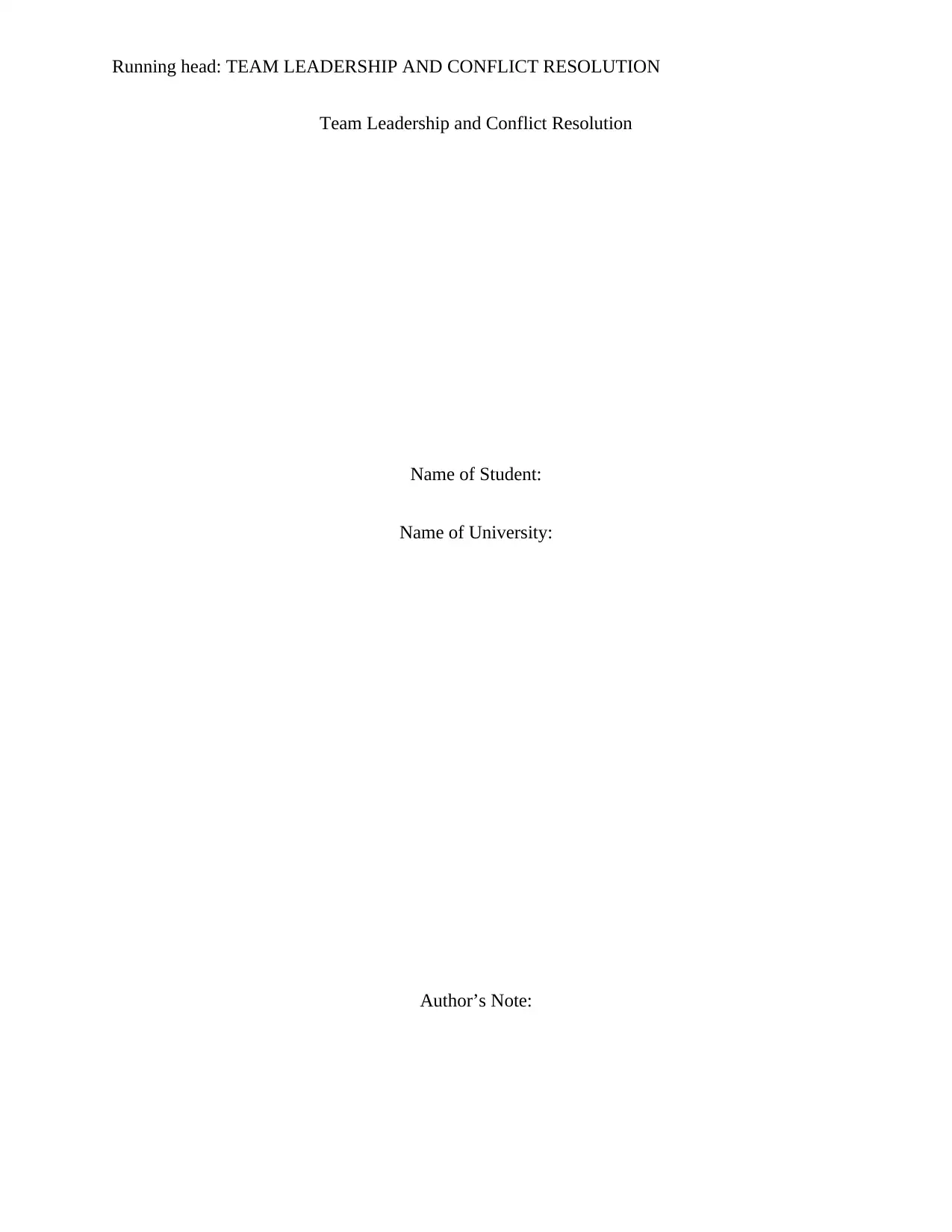
Running head: TEAM LEADERSHIP AND CONFLICT RESOLUTION
Team Leadership and Conflict Resolution
Name of Student:
Name of University:
Author’s Note:
Team Leadership and Conflict Resolution
Name of Student:
Name of University:
Author’s Note:
Paraphrase This Document
Need a fresh take? Get an instant paraphrase of this document with our AI Paraphraser
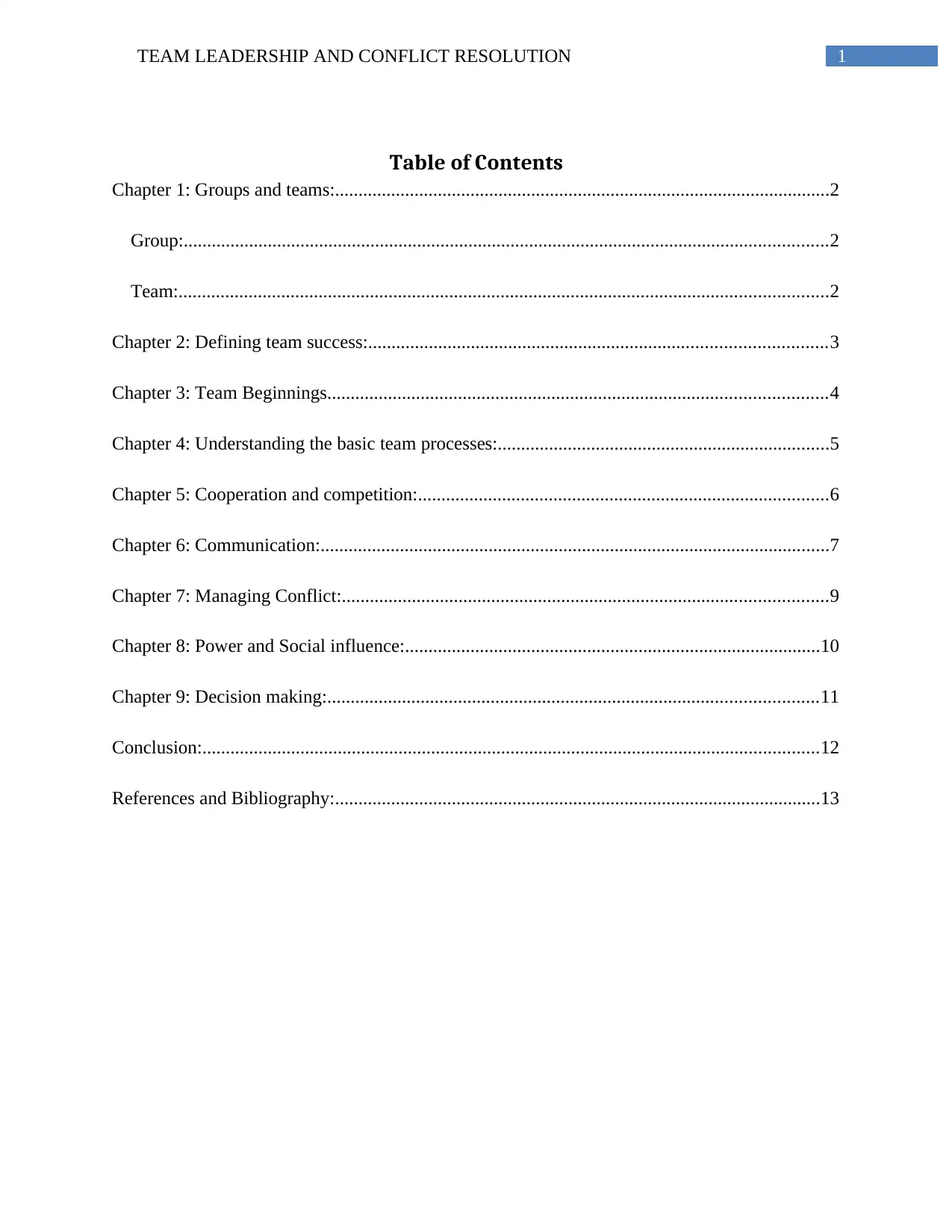
1TEAM LEADERSHIP AND CONFLICT RESOLUTION
Table of Contents
Chapter 1: Groups and teams:..........................................................................................................2
Group:..........................................................................................................................................2
Team:...........................................................................................................................................2
Chapter 2: Defining team success:..................................................................................................3
Chapter 3: Team Beginnings...........................................................................................................4
Chapter 4: Understanding the basic team processes:.......................................................................5
Chapter 5: Cooperation and competition:........................................................................................6
Chapter 6: Communication:.............................................................................................................7
Chapter 7: Managing Conflict:........................................................................................................9
Chapter 8: Power and Social influence:.........................................................................................10
Chapter 9: Decision making:.........................................................................................................11
Conclusion:....................................................................................................................................12
References and Bibliography:........................................................................................................13
Table of Contents
Chapter 1: Groups and teams:..........................................................................................................2
Group:..........................................................................................................................................2
Team:...........................................................................................................................................2
Chapter 2: Defining team success:..................................................................................................3
Chapter 3: Team Beginnings...........................................................................................................4
Chapter 4: Understanding the basic team processes:.......................................................................5
Chapter 5: Cooperation and competition:........................................................................................6
Chapter 6: Communication:.............................................................................................................7
Chapter 7: Managing Conflict:........................................................................................................9
Chapter 8: Power and Social influence:.........................................................................................10
Chapter 9: Decision making:.........................................................................................................11
Conclusion:....................................................................................................................................12
References and Bibliography:........................................................................................................13
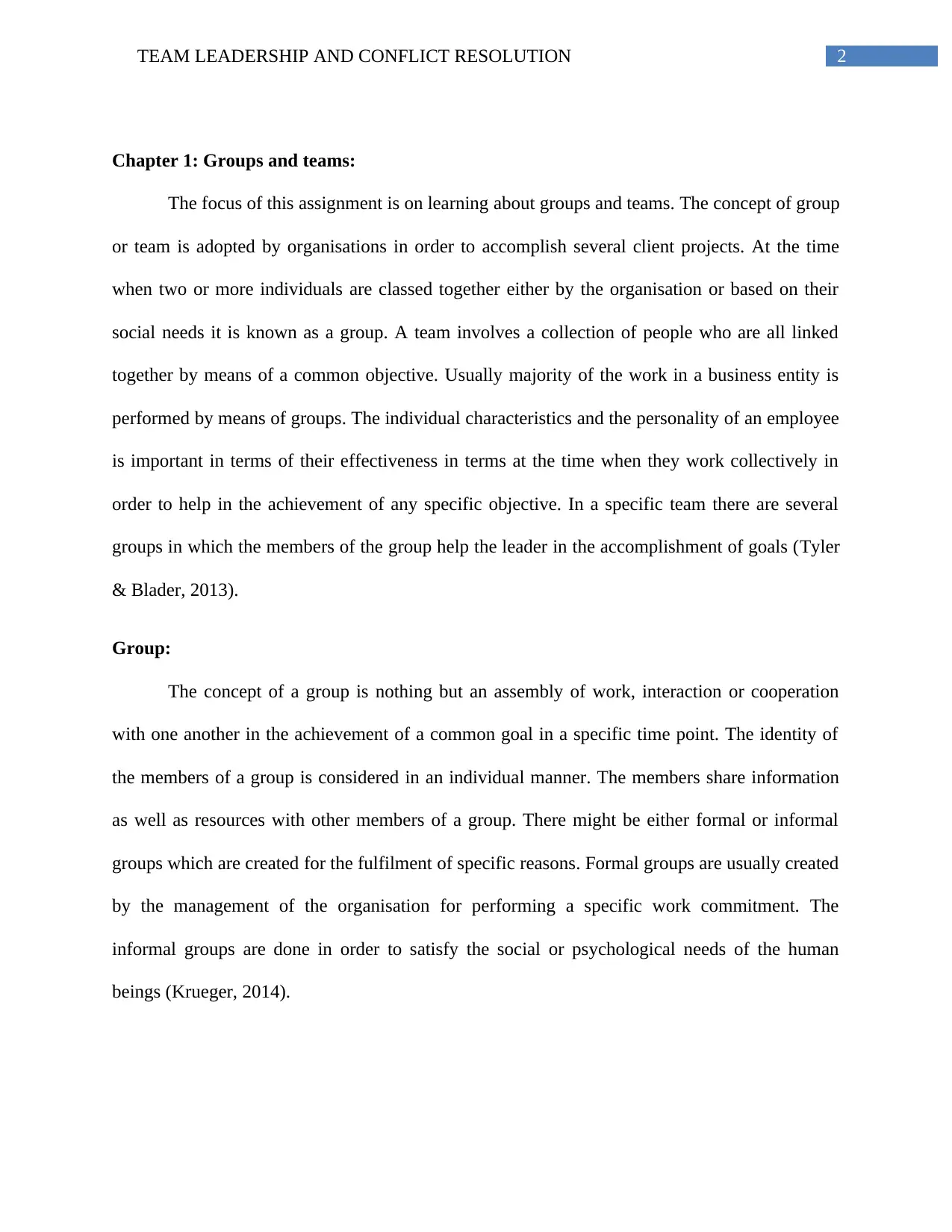
2TEAM LEADERSHIP AND CONFLICT RESOLUTION
Chapter 1: Groups and teams:
The focus of this assignment is on learning about groups and teams. The concept of group
or team is adopted by organisations in order to accomplish several client projects. At the time
when two or more individuals are classed together either by the organisation or based on their
social needs it is known as a group. A team involves a collection of people who are all linked
together by means of a common objective. Usually majority of the work in a business entity is
performed by means of groups. The individual characteristics and the personality of an employee
is important in terms of their effectiveness in terms at the time when they work collectively in
order to help in the achievement of any specific objective. In a specific team there are several
groups in which the members of the group help the leader in the accomplishment of goals (Tyler
& Blader, 2013).
Group:
The concept of a group is nothing but an assembly of work, interaction or cooperation
with one another in the achievement of a common goal in a specific time point. The identity of
the members of a group is considered in an individual manner. The members share information
as well as resources with other members of a group. There might be either formal or informal
groups which are created for the fulfilment of specific reasons. Formal groups are usually created
by the management of the organisation for performing a specific work commitment. The
informal groups are done in order to satisfy the social or psychological needs of the human
beings (Krueger, 2014).
Chapter 1: Groups and teams:
The focus of this assignment is on learning about groups and teams. The concept of group
or team is adopted by organisations in order to accomplish several client projects. At the time
when two or more individuals are classed together either by the organisation or based on their
social needs it is known as a group. A team involves a collection of people who are all linked
together by means of a common objective. Usually majority of the work in a business entity is
performed by means of groups. The individual characteristics and the personality of an employee
is important in terms of their effectiveness in terms at the time when they work collectively in
order to help in the achievement of any specific objective. In a specific team there are several
groups in which the members of the group help the leader in the accomplishment of goals (Tyler
& Blader, 2013).
Group:
The concept of a group is nothing but an assembly of work, interaction or cooperation
with one another in the achievement of a common goal in a specific time point. The identity of
the members of a group is considered in an individual manner. The members share information
as well as resources with other members of a group. There might be either formal or informal
groups which are created for the fulfilment of specific reasons. Formal groups are usually created
by the management of the organisation for performing a specific work commitment. The
informal groups are done in order to satisfy the social or psychological needs of the human
beings (Krueger, 2014).
⊘ This is a preview!⊘
Do you want full access?
Subscribe today to unlock all pages.

Trusted by 1+ million students worldwide
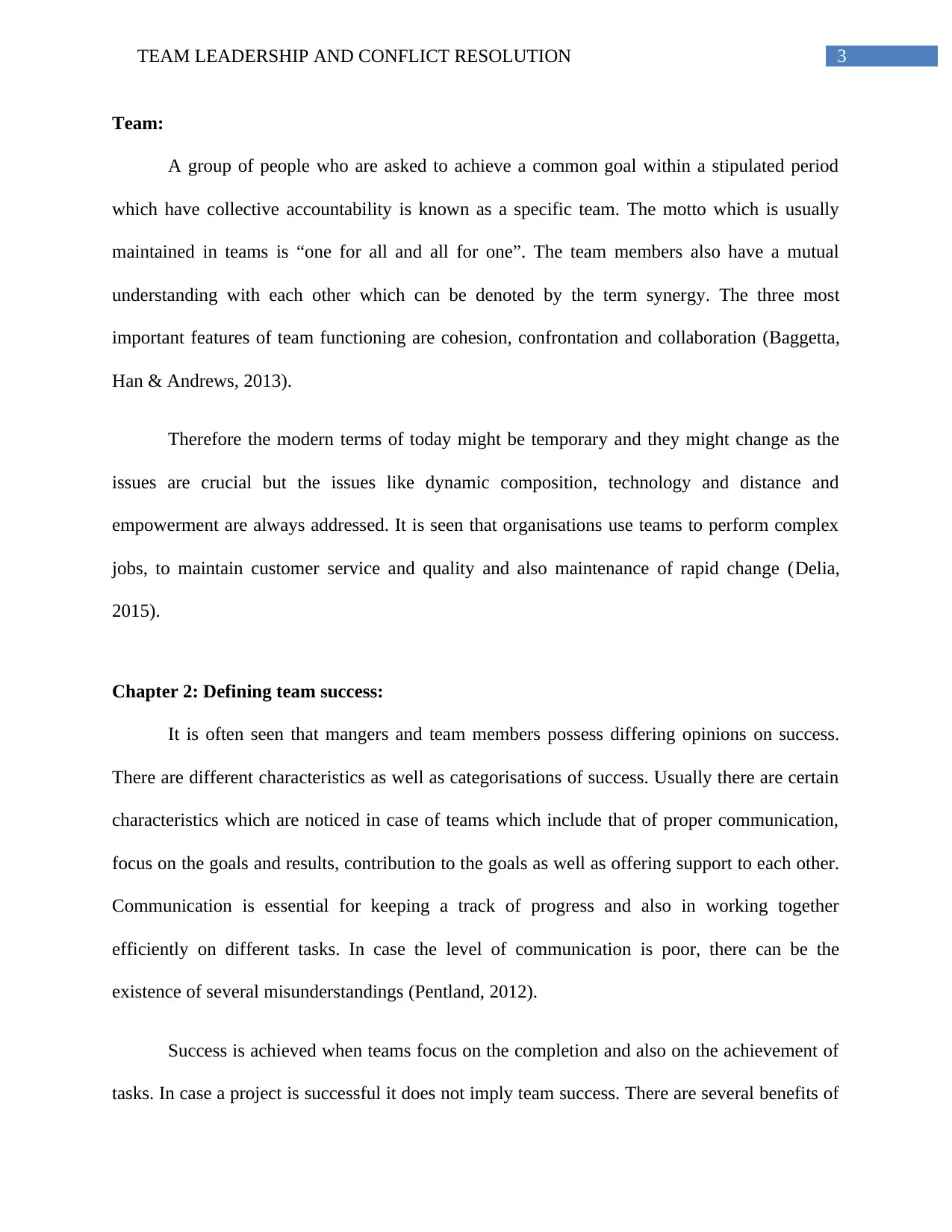
3TEAM LEADERSHIP AND CONFLICT RESOLUTION
Team:
A group of people who are asked to achieve a common goal within a stipulated period
which have collective accountability is known as a specific team. The motto which is usually
maintained in teams is “one for all and all for one”. The team members also have a mutual
understanding with each other which can be denoted by the term synergy. The three most
important features of team functioning are cohesion, confrontation and collaboration (Baggetta,
Han & Andrews, 2013).
Therefore the modern terms of today might be temporary and they might change as the
issues are crucial but the issues like dynamic composition, technology and distance and
empowerment are always addressed. It is seen that organisations use teams to perform complex
jobs, to maintain customer service and quality and also maintenance of rapid change (Delia,
2015).
Chapter 2: Defining team success:
It is often seen that mangers and team members possess differing opinions on success.
There are different characteristics as well as categorisations of success. Usually there are certain
characteristics which are noticed in case of teams which include that of proper communication,
focus on the goals and results, contribution to the goals as well as offering support to each other.
Communication is essential for keeping a track of progress and also in working together
efficiently on different tasks. In case the level of communication is poor, there can be the
existence of several misunderstandings (Pentland, 2012).
Success is achieved when teams focus on the completion and also on the achievement of
tasks. In case a project is successful it does not imply team success. There are several benefits of
Team:
A group of people who are asked to achieve a common goal within a stipulated period
which have collective accountability is known as a specific team. The motto which is usually
maintained in teams is “one for all and all for one”. The team members also have a mutual
understanding with each other which can be denoted by the term synergy. The three most
important features of team functioning are cohesion, confrontation and collaboration (Baggetta,
Han & Andrews, 2013).
Therefore the modern terms of today might be temporary and they might change as the
issues are crucial but the issues like dynamic composition, technology and distance and
empowerment are always addressed. It is seen that organisations use teams to perform complex
jobs, to maintain customer service and quality and also maintenance of rapid change (Delia,
2015).
Chapter 2: Defining team success:
It is often seen that mangers and team members possess differing opinions on success.
There are different characteristics as well as categorisations of success. Usually there are certain
characteristics which are noticed in case of teams which include that of proper communication,
focus on the goals and results, contribution to the goals as well as offering support to each other.
Communication is essential for keeping a track of progress and also in working together
efficiently on different tasks. In case the level of communication is poor, there can be the
existence of several misunderstandings (Pentland, 2012).
Success is achieved when teams focus on the completion and also on the achievement of
tasks. In case a project is successful it does not imply team success. There are several benefits of
Paraphrase This Document
Need a fresh take? Get an instant paraphrase of this document with our AI Paraphraser
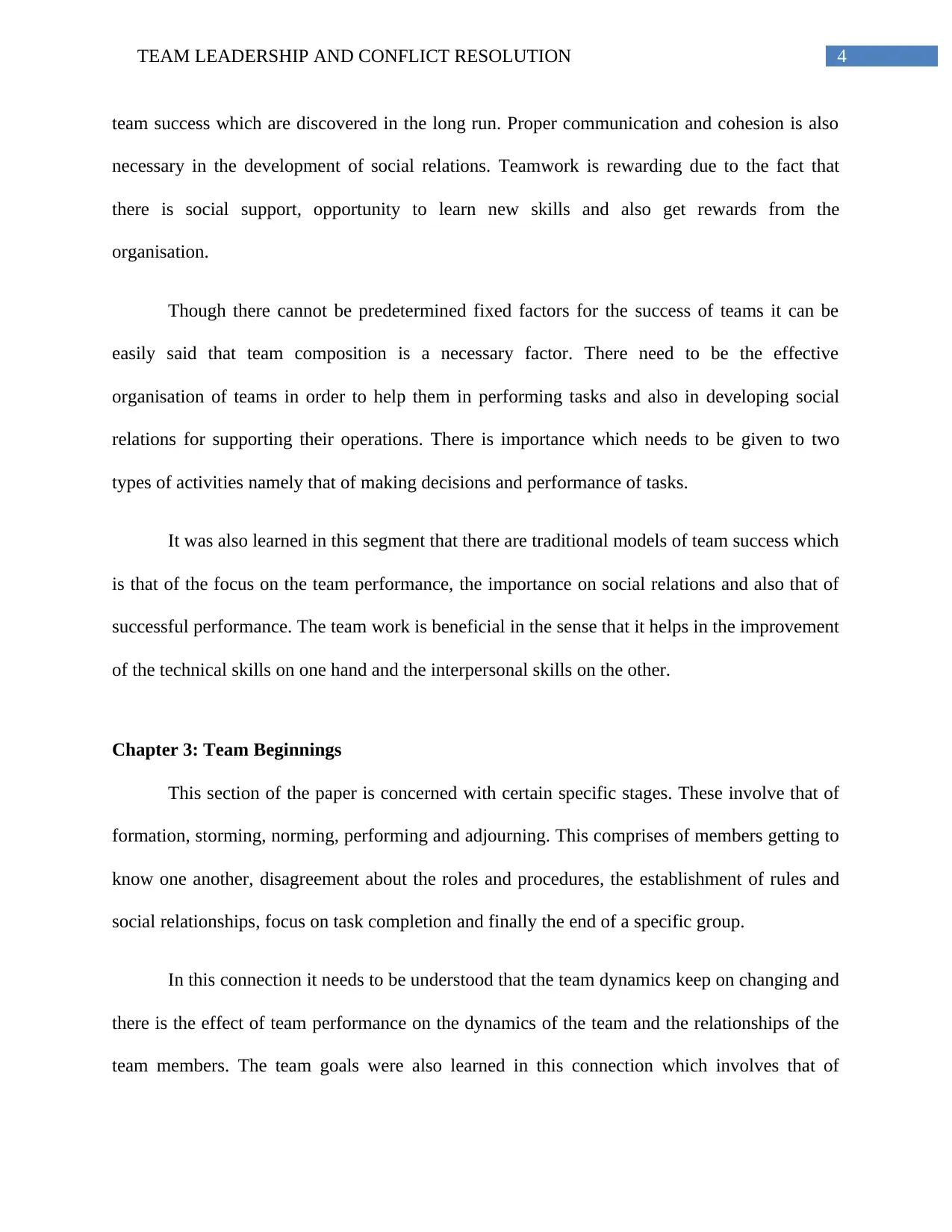
4TEAM LEADERSHIP AND CONFLICT RESOLUTION
team success which are discovered in the long run. Proper communication and cohesion is also
necessary in the development of social relations. Teamwork is rewarding due to the fact that
there is social support, opportunity to learn new skills and also get rewards from the
organisation.
Though there cannot be predetermined fixed factors for the success of teams it can be
easily said that team composition is a necessary factor. There need to be the effective
organisation of teams in order to help them in performing tasks and also in developing social
relations for supporting their operations. There is importance which needs to be given to two
types of activities namely that of making decisions and performance of tasks.
It was also learned in this segment that there are traditional models of team success which
is that of the focus on the team performance, the importance on social relations and also that of
successful performance. The team work is beneficial in the sense that it helps in the improvement
of the technical skills on one hand and the interpersonal skills on the other.
Chapter 3: Team Beginnings
This section of the paper is concerned with certain specific stages. These involve that of
formation, storming, norming, performing and adjourning. This comprises of members getting to
know one another, disagreement about the roles and procedures, the establishment of rules and
social relationships, focus on task completion and finally the end of a specific group.
In this connection it needs to be understood that the team dynamics keep on changing and
there is the effect of team performance on the dynamics of the team and the relationships of the
team members. The team goals were also learned in this connection which involves that of
team success which are discovered in the long run. Proper communication and cohesion is also
necessary in the development of social relations. Teamwork is rewarding due to the fact that
there is social support, opportunity to learn new skills and also get rewards from the
organisation.
Though there cannot be predetermined fixed factors for the success of teams it can be
easily said that team composition is a necessary factor. There need to be the effective
organisation of teams in order to help them in performing tasks and also in developing social
relations for supporting their operations. There is importance which needs to be given to two
types of activities namely that of making decisions and performance of tasks.
It was also learned in this segment that there are traditional models of team success which
is that of the focus on the team performance, the importance on social relations and also that of
successful performance. The team work is beneficial in the sense that it helps in the improvement
of the technical skills on one hand and the interpersonal skills on the other.
Chapter 3: Team Beginnings
This section of the paper is concerned with certain specific stages. These involve that of
formation, storming, norming, performing and adjourning. This comprises of members getting to
know one another, disagreement about the roles and procedures, the establishment of rules and
social relationships, focus on task completion and finally the end of a specific group.
In this connection it needs to be understood that the team dynamics keep on changing and
there is the effect of team performance on the dynamics of the team and the relationships of the
team members. The team goals were also learned in this connection which involves that of
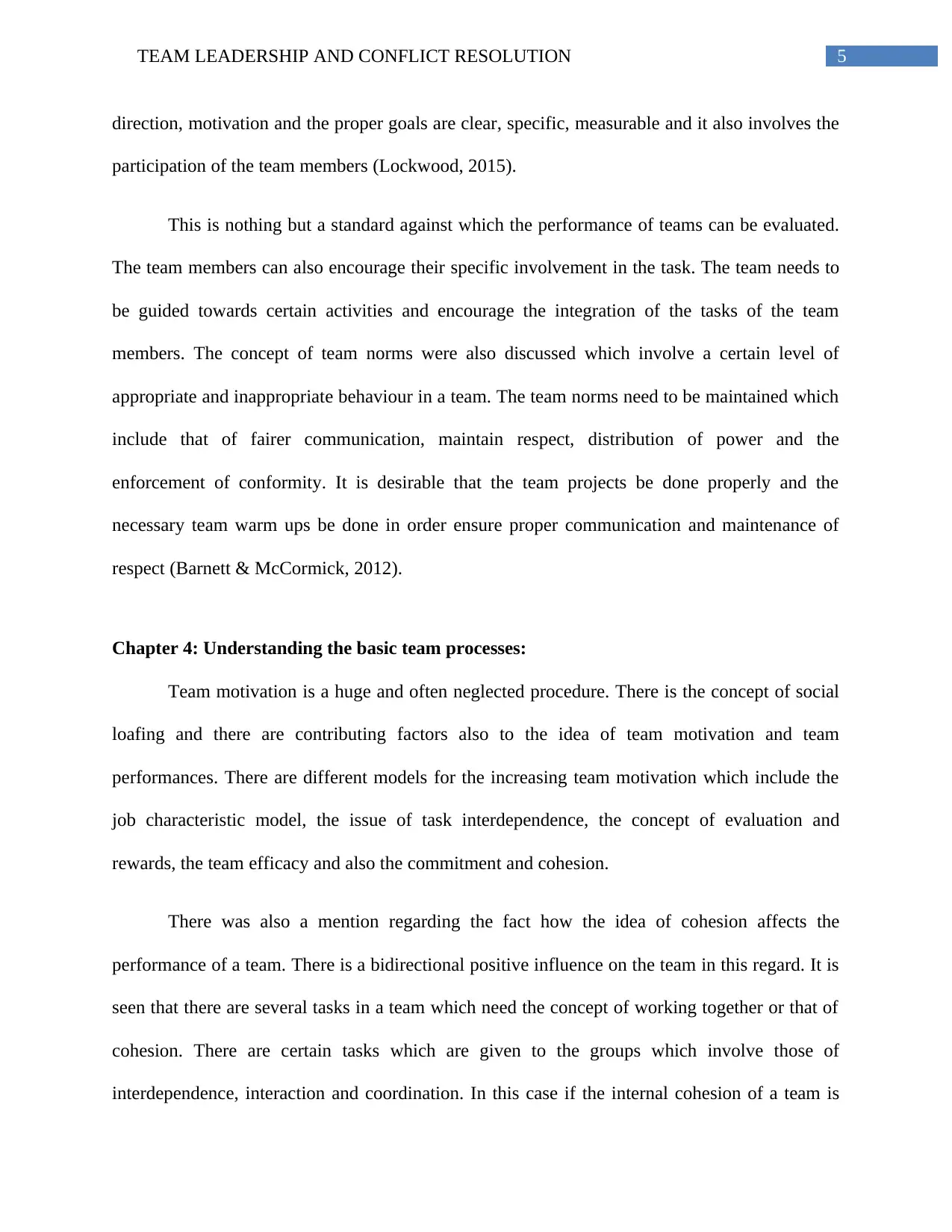
5TEAM LEADERSHIP AND CONFLICT RESOLUTION
direction, motivation and the proper goals are clear, specific, measurable and it also involves the
participation of the team members (Lockwood, 2015).
This is nothing but a standard against which the performance of teams can be evaluated.
The team members can also encourage their specific involvement in the task. The team needs to
be guided towards certain activities and encourage the integration of the tasks of the team
members. The concept of team norms were also discussed which involve a certain level of
appropriate and inappropriate behaviour in a team. The team norms need to be maintained which
include that of fairer communication, maintain respect, distribution of power and the
enforcement of conformity. It is desirable that the team projects be done properly and the
necessary team warm ups be done in order ensure proper communication and maintenance of
respect (Barnett & McCormick, 2012).
Chapter 4: Understanding the basic team processes:
Team motivation is a huge and often neglected procedure. There is the concept of social
loafing and there are contributing factors also to the idea of team motivation and team
performances. There are different models for the increasing team motivation which include the
job characteristic model, the issue of task interdependence, the concept of evaluation and
rewards, the team efficacy and also the commitment and cohesion.
There was also a mention regarding the fact how the idea of cohesion affects the
performance of a team. There is a bidirectional positive influence on the team in this regard. It is
seen that there are several tasks in a team which need the concept of working together or that of
cohesion. There are certain tasks which are given to the groups which involve those of
interdependence, interaction and coordination. In this case if the internal cohesion of a team is
direction, motivation and the proper goals are clear, specific, measurable and it also involves the
participation of the team members (Lockwood, 2015).
This is nothing but a standard against which the performance of teams can be evaluated.
The team members can also encourage their specific involvement in the task. The team needs to
be guided towards certain activities and encourage the integration of the tasks of the team
members. The concept of team norms were also discussed which involve a certain level of
appropriate and inappropriate behaviour in a team. The team norms need to be maintained which
include that of fairer communication, maintain respect, distribution of power and the
enforcement of conformity. It is desirable that the team projects be done properly and the
necessary team warm ups be done in order ensure proper communication and maintenance of
respect (Barnett & McCormick, 2012).
Chapter 4: Understanding the basic team processes:
Team motivation is a huge and often neglected procedure. There is the concept of social
loafing and there are contributing factors also to the idea of team motivation and team
performances. There are different models for the increasing team motivation which include the
job characteristic model, the issue of task interdependence, the concept of evaluation and
rewards, the team efficacy and also the commitment and cohesion.
There was also a mention regarding the fact how the idea of cohesion affects the
performance of a team. There is a bidirectional positive influence on the team in this regard. It is
seen that there are several tasks in a team which need the concept of working together or that of
cohesion. There are certain tasks which are given to the groups which involve those of
interdependence, interaction and coordination. In this case if the internal cohesion of a team is
⊘ This is a preview!⊘
Do you want full access?
Subscribe today to unlock all pages.

Trusted by 1+ million students worldwide
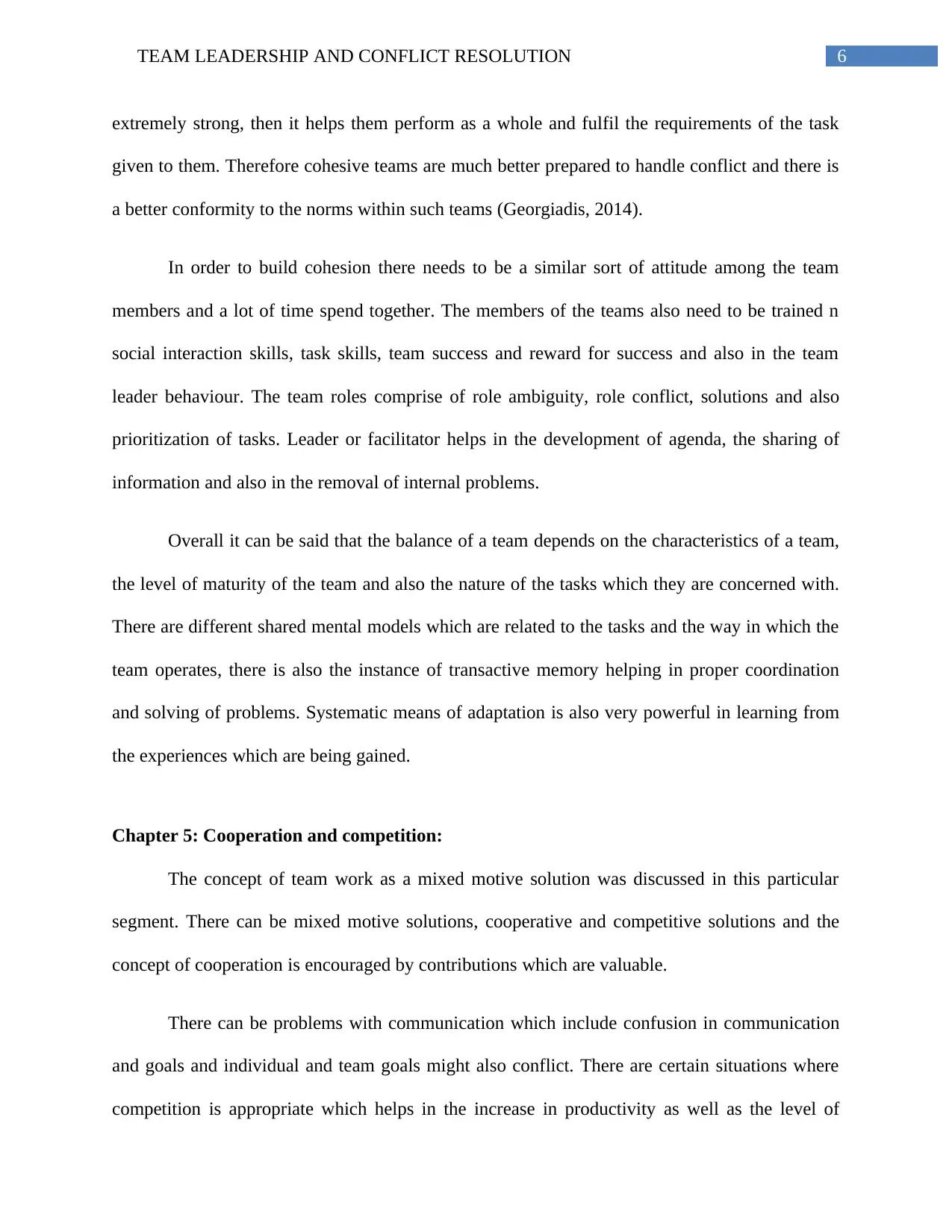
6TEAM LEADERSHIP AND CONFLICT RESOLUTION
extremely strong, then it helps them perform as a whole and fulfil the requirements of the task
given to them. Therefore cohesive teams are much better prepared to handle conflict and there is
a better conformity to the norms within such teams (Georgiadis, 2014).
In order to build cohesion there needs to be a similar sort of attitude among the team
members and a lot of time spend together. The members of the teams also need to be trained n
social interaction skills, task skills, team success and reward for success and also in the team
leader behaviour. The team roles comprise of role ambiguity, role conflict, solutions and also
prioritization of tasks. Leader or facilitator helps in the development of agenda, the sharing of
information and also in the removal of internal problems.
Overall it can be said that the balance of a team depends on the characteristics of a team,
the level of maturity of the team and also the nature of the tasks which they are concerned with.
There are different shared mental models which are related to the tasks and the way in which the
team operates, there is also the instance of transactive memory helping in proper coordination
and solving of problems. Systematic means of adaptation is also very powerful in learning from
the experiences which are being gained.
Chapter 5: Cooperation and competition:
The concept of team work as a mixed motive solution was discussed in this particular
segment. There can be mixed motive solutions, cooperative and competitive solutions and the
concept of cooperation is encouraged by contributions which are valuable.
There can be problems with communication which include confusion in communication
and goals and individual and team goals might also conflict. There are certain situations where
competition is appropriate which helps in the increase in productivity as well as the level of
extremely strong, then it helps them perform as a whole and fulfil the requirements of the task
given to them. Therefore cohesive teams are much better prepared to handle conflict and there is
a better conformity to the norms within such teams (Georgiadis, 2014).
In order to build cohesion there needs to be a similar sort of attitude among the team
members and a lot of time spend together. The members of the teams also need to be trained n
social interaction skills, task skills, team success and reward for success and also in the team
leader behaviour. The team roles comprise of role ambiguity, role conflict, solutions and also
prioritization of tasks. Leader or facilitator helps in the development of agenda, the sharing of
information and also in the removal of internal problems.
Overall it can be said that the balance of a team depends on the characteristics of a team,
the level of maturity of the team and also the nature of the tasks which they are concerned with.
There are different shared mental models which are related to the tasks and the way in which the
team operates, there is also the instance of transactive memory helping in proper coordination
and solving of problems. Systematic means of adaptation is also very powerful in learning from
the experiences which are being gained.
Chapter 5: Cooperation and competition:
The concept of team work as a mixed motive solution was discussed in this particular
segment. There can be mixed motive solutions, cooperative and competitive solutions and the
concept of cooperation is encouraged by contributions which are valuable.
There can be problems with communication which include confusion in communication
and goals and individual and team goals might also conflict. There are certain situations where
competition is appropriate which helps in the increase in productivity as well as the level of
Paraphrase This Document
Need a fresh take? Get an instant paraphrase of this document with our AI Paraphraser
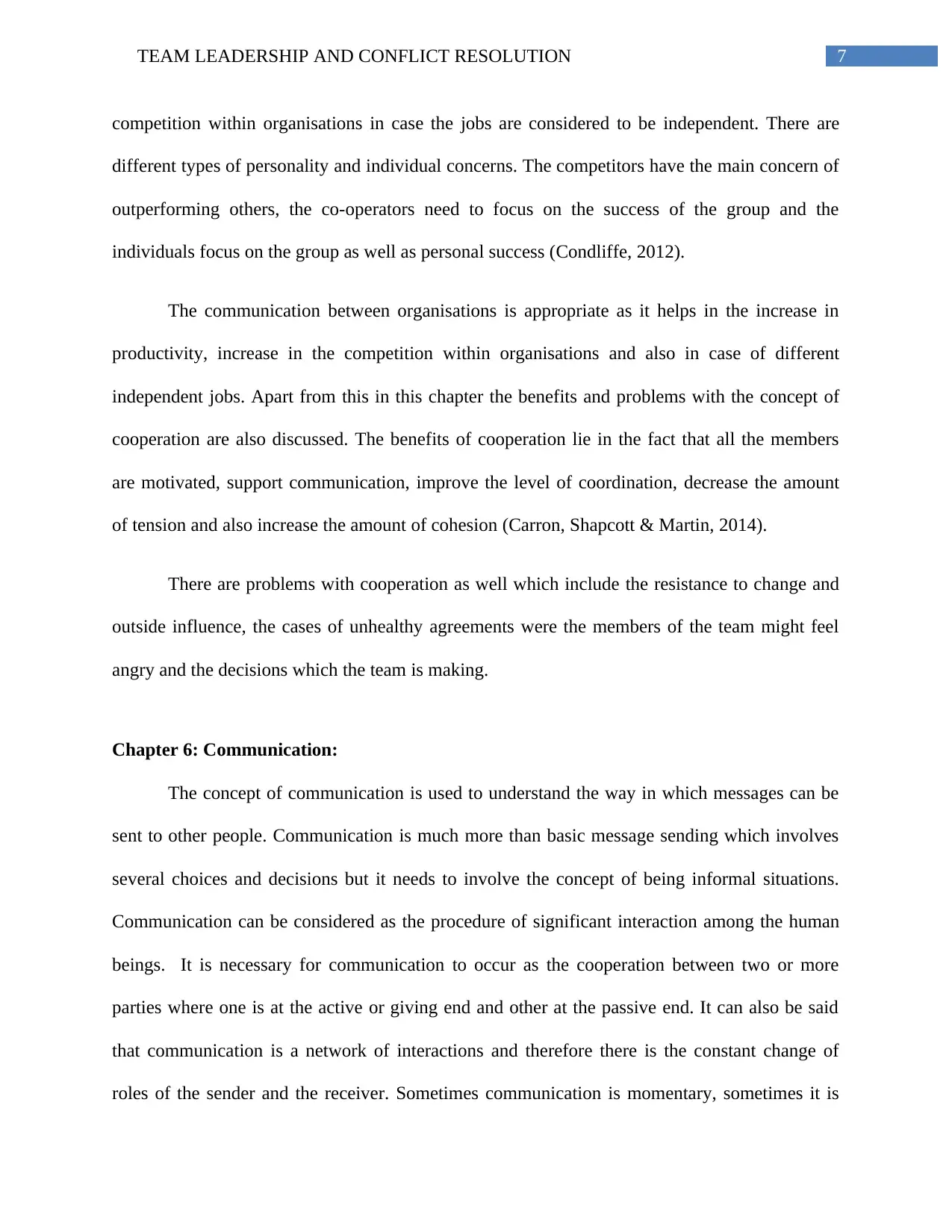
7TEAM LEADERSHIP AND CONFLICT RESOLUTION
competition within organisations in case the jobs are considered to be independent. There are
different types of personality and individual concerns. The competitors have the main concern of
outperforming others, the co-operators need to focus on the success of the group and the
individuals focus on the group as well as personal success (Condliffe, 2012).
The communication between organisations is appropriate as it helps in the increase in
productivity, increase in the competition within organisations and also in case of different
independent jobs. Apart from this in this chapter the benefits and problems with the concept of
cooperation are also discussed. The benefits of cooperation lie in the fact that all the members
are motivated, support communication, improve the level of coordination, decrease the amount
of tension and also increase the amount of cohesion (Carron, Shapcott & Martin, 2014).
There are problems with cooperation as well which include the resistance to change and
outside influence, the cases of unhealthy agreements were the members of the team might feel
angry and the decisions which the team is making.
Chapter 6: Communication:
The concept of communication is used to understand the way in which messages can be
sent to other people. Communication is much more than basic message sending which involves
several choices and decisions but it needs to involve the concept of being informal situations.
Communication can be considered as the procedure of significant interaction among the human
beings. It is necessary for communication to occur as the cooperation between two or more
parties where one is at the active or giving end and other at the passive end. It can also be said
that communication is a network of interactions and therefore there is the constant change of
roles of the sender and the receiver. Sometimes communication is momentary, sometimes it is
competition within organisations in case the jobs are considered to be independent. There are
different types of personality and individual concerns. The competitors have the main concern of
outperforming others, the co-operators need to focus on the success of the group and the
individuals focus on the group as well as personal success (Condliffe, 2012).
The communication between organisations is appropriate as it helps in the increase in
productivity, increase in the competition within organisations and also in case of different
independent jobs. Apart from this in this chapter the benefits and problems with the concept of
cooperation are also discussed. The benefits of cooperation lie in the fact that all the members
are motivated, support communication, improve the level of coordination, decrease the amount
of tension and also increase the amount of cohesion (Carron, Shapcott & Martin, 2014).
There are problems with cooperation as well which include the resistance to change and
outside influence, the cases of unhealthy agreements were the members of the team might feel
angry and the decisions which the team is making.
Chapter 6: Communication:
The concept of communication is used to understand the way in which messages can be
sent to other people. Communication is much more than basic message sending which involves
several choices and decisions but it needs to involve the concept of being informal situations.
Communication can be considered as the procedure of significant interaction among the human
beings. It is necessary for communication to occur as the cooperation between two or more
parties where one is at the active or giving end and other at the passive end. It can also be said
that communication is a network of interactions and therefore there is the constant change of
roles of the sender and the receiver. Sometimes communication is momentary, sometimes it is
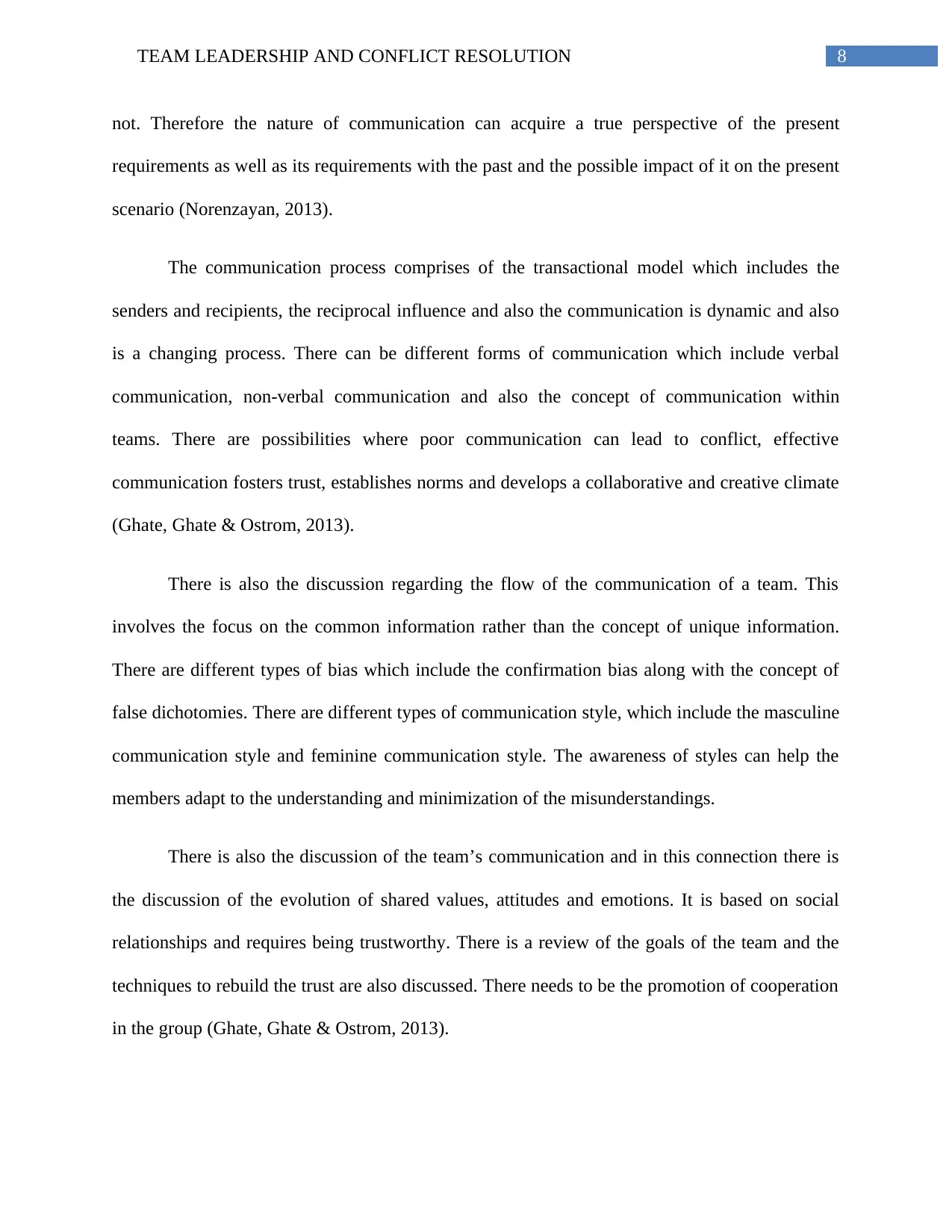
8TEAM LEADERSHIP AND CONFLICT RESOLUTION
not. Therefore the nature of communication can acquire a true perspective of the present
requirements as well as its requirements with the past and the possible impact of it on the present
scenario (Norenzayan, 2013).
The communication process comprises of the transactional model which includes the
senders and recipients, the reciprocal influence and also the communication is dynamic and also
is a changing process. There can be different forms of communication which include verbal
communication, non-verbal communication and also the concept of communication within
teams. There are possibilities where poor communication can lead to conflict, effective
communication fosters trust, establishes norms and develops a collaborative and creative climate
(Ghate, Ghate & Ostrom, 2013).
There is also the discussion regarding the flow of the communication of a team. This
involves the focus on the common information rather than the concept of unique information.
There are different types of bias which include the confirmation bias along with the concept of
false dichotomies. There are different types of communication style, which include the masculine
communication style and feminine communication style. The awareness of styles can help the
members adapt to the understanding and minimization of the misunderstandings.
There is also the discussion of the team’s communication and in this connection there is
the discussion of the evolution of shared values, attitudes and emotions. It is based on social
relationships and requires being trustworthy. There is a review of the goals of the team and the
techniques to rebuild the trust are also discussed. There needs to be the promotion of cooperation
in the group (Ghate, Ghate & Ostrom, 2013).
not. Therefore the nature of communication can acquire a true perspective of the present
requirements as well as its requirements with the past and the possible impact of it on the present
scenario (Norenzayan, 2013).
The communication process comprises of the transactional model which includes the
senders and recipients, the reciprocal influence and also the communication is dynamic and also
is a changing process. There can be different forms of communication which include verbal
communication, non-verbal communication and also the concept of communication within
teams. There are possibilities where poor communication can lead to conflict, effective
communication fosters trust, establishes norms and develops a collaborative and creative climate
(Ghate, Ghate & Ostrom, 2013).
There is also the discussion regarding the flow of the communication of a team. This
involves the focus on the common information rather than the concept of unique information.
There are different types of bias which include the confirmation bias along with the concept of
false dichotomies. There are different types of communication style, which include the masculine
communication style and feminine communication style. The awareness of styles can help the
members adapt to the understanding and minimization of the misunderstandings.
There is also the discussion of the team’s communication and in this connection there is
the discussion of the evolution of shared values, attitudes and emotions. It is based on social
relationships and requires being trustworthy. There is a review of the goals of the team and the
techniques to rebuild the trust are also discussed. There needs to be the promotion of cooperation
in the group (Ghate, Ghate & Ostrom, 2013).
⊘ This is a preview!⊘
Do you want full access?
Subscribe today to unlock all pages.

Trusted by 1+ million students worldwide
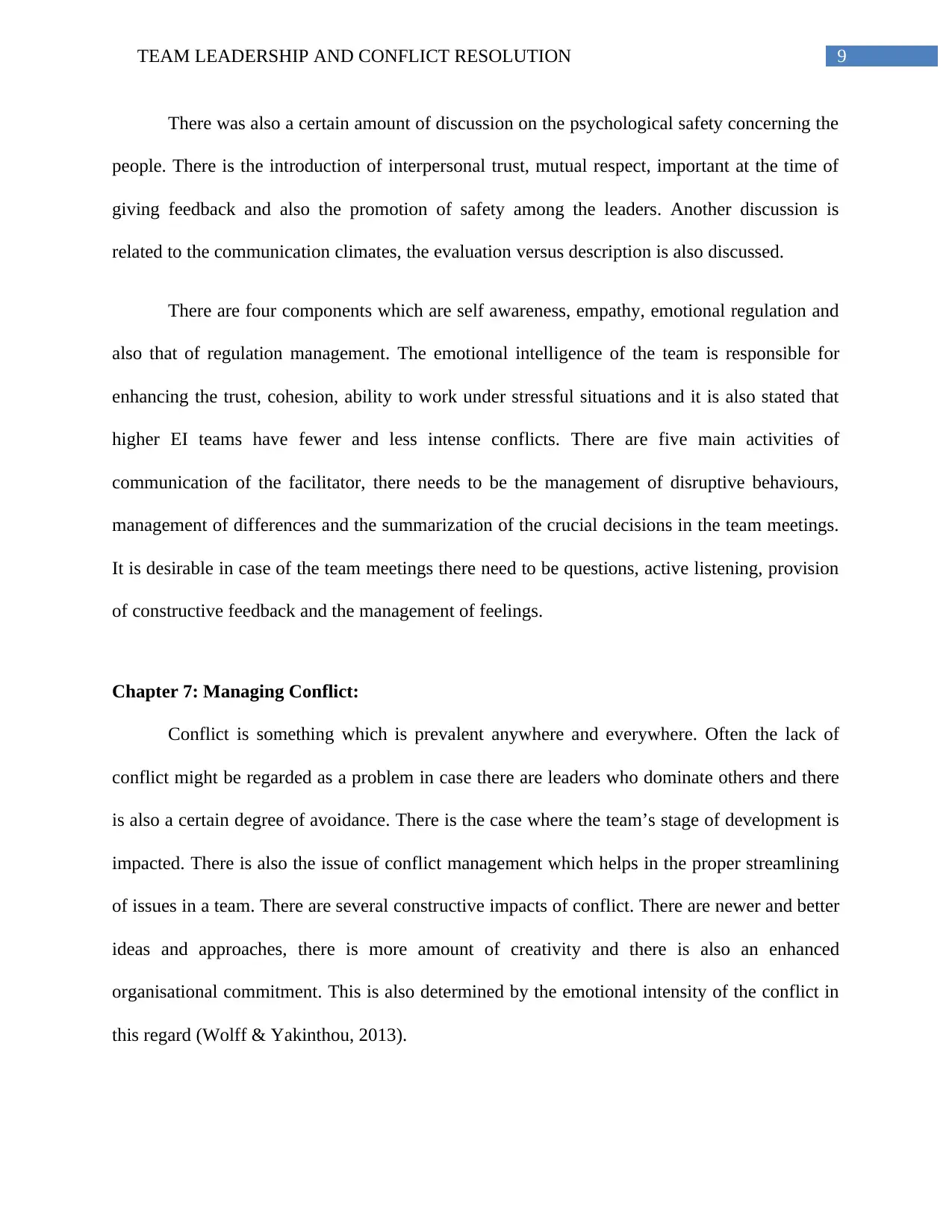
9TEAM LEADERSHIP AND CONFLICT RESOLUTION
There was also a certain amount of discussion on the psychological safety concerning the
people. There is the introduction of interpersonal trust, mutual respect, important at the time of
giving feedback and also the promotion of safety among the leaders. Another discussion is
related to the communication climates, the evaluation versus description is also discussed.
There are four components which are self awareness, empathy, emotional regulation and
also that of regulation management. The emotional intelligence of the team is responsible for
enhancing the trust, cohesion, ability to work under stressful situations and it is also stated that
higher EI teams have fewer and less intense conflicts. There are five main activities of
communication of the facilitator, there needs to be the management of disruptive behaviours,
management of differences and the summarization of the crucial decisions in the team meetings.
It is desirable in case of the team meetings there need to be questions, active listening, provision
of constructive feedback and the management of feelings.
Chapter 7: Managing Conflict:
Conflict is something which is prevalent anywhere and everywhere. Often the lack of
conflict might be regarded as a problem in case there are leaders who dominate others and there
is also a certain degree of avoidance. There is the case where the team’s stage of development is
impacted. There is also the issue of conflict management which helps in the proper streamlining
of issues in a team. There are several constructive impacts of conflict. There are newer and better
ideas and approaches, there is more amount of creativity and there is also an enhanced
organisational commitment. This is also determined by the emotional intensity of the conflict in
this regard (Wolff & Yakinthou, 2013).
There was also a certain amount of discussion on the psychological safety concerning the
people. There is the introduction of interpersonal trust, mutual respect, important at the time of
giving feedback and also the promotion of safety among the leaders. Another discussion is
related to the communication climates, the evaluation versus description is also discussed.
There are four components which are self awareness, empathy, emotional regulation and
also that of regulation management. The emotional intelligence of the team is responsible for
enhancing the trust, cohesion, ability to work under stressful situations and it is also stated that
higher EI teams have fewer and less intense conflicts. There are five main activities of
communication of the facilitator, there needs to be the management of disruptive behaviours,
management of differences and the summarization of the crucial decisions in the team meetings.
It is desirable in case of the team meetings there need to be questions, active listening, provision
of constructive feedback and the management of feelings.
Chapter 7: Managing Conflict:
Conflict is something which is prevalent anywhere and everywhere. Often the lack of
conflict might be regarded as a problem in case there are leaders who dominate others and there
is also a certain degree of avoidance. There is the case where the team’s stage of development is
impacted. There is also the issue of conflict management which helps in the proper streamlining
of issues in a team. There are several constructive impacts of conflict. There are newer and better
ideas and approaches, there is more amount of creativity and there is also an enhanced
organisational commitment. This is also determined by the emotional intensity of the conflict in
this regard (Wolff & Yakinthou, 2013).
Paraphrase This Document
Need a fresh take? Get an instant paraphrase of this document with our AI Paraphraser
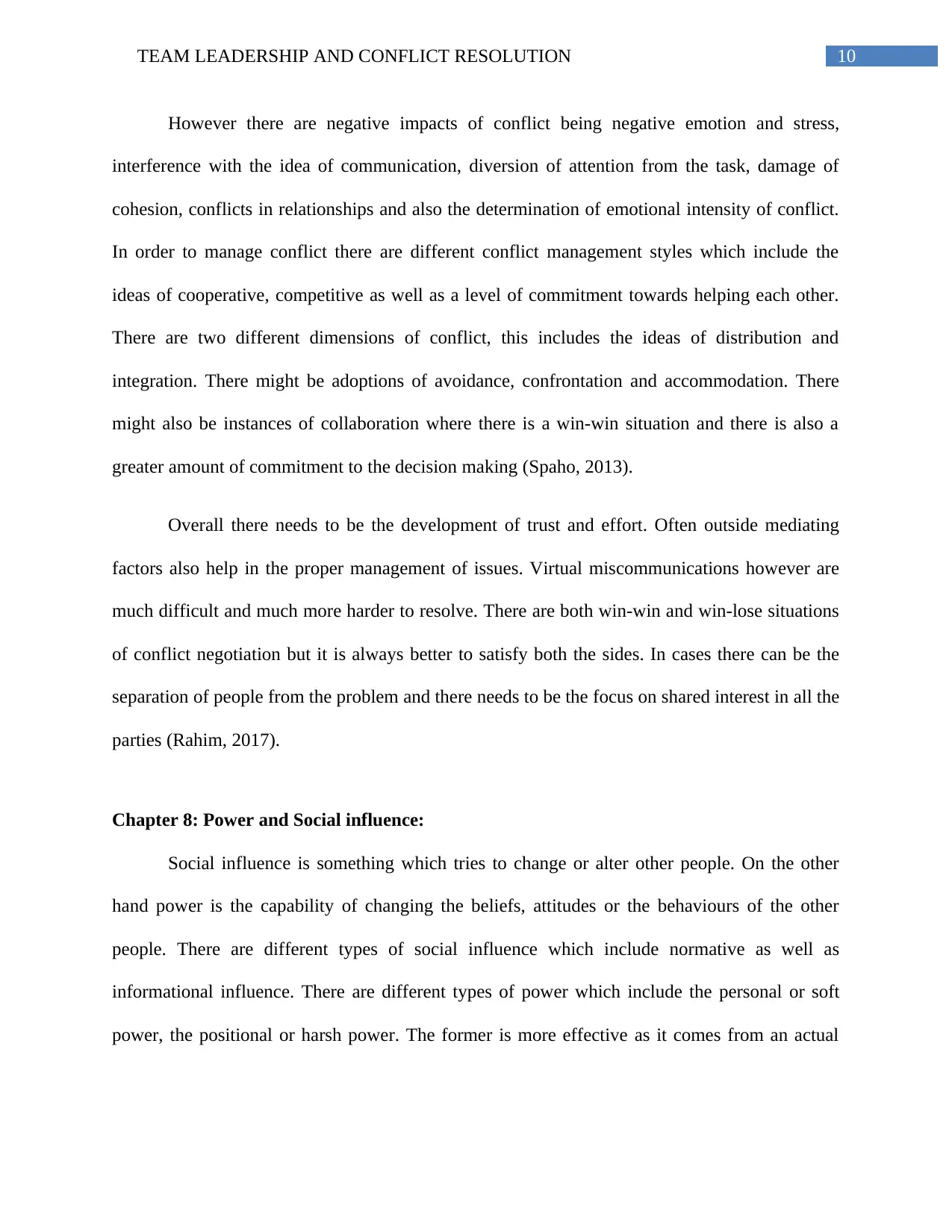
10TEAM LEADERSHIP AND CONFLICT RESOLUTION
However there are negative impacts of conflict being negative emotion and stress,
interference with the idea of communication, diversion of attention from the task, damage of
cohesion, conflicts in relationships and also the determination of emotional intensity of conflict.
In order to manage conflict there are different conflict management styles which include the
ideas of cooperative, competitive as well as a level of commitment towards helping each other.
There are two different dimensions of conflict, this includes the ideas of distribution and
integration. There might be adoptions of avoidance, confrontation and accommodation. There
might also be instances of collaboration where there is a win-win situation and there is also a
greater amount of commitment to the decision making (Spaho, 2013).
Overall there needs to be the development of trust and effort. Often outside mediating
factors also help in the proper management of issues. Virtual miscommunications however are
much difficult and much more harder to resolve. There are both win-win and win-lose situations
of conflict negotiation but it is always better to satisfy both the sides. In cases there can be the
separation of people from the problem and there needs to be the focus on shared interest in all the
parties (Rahim, 2017).
Chapter 8: Power and Social influence:
Social influence is something which tries to change or alter other people. On the other
hand power is the capability of changing the beliefs, attitudes or the behaviours of the other
people. There are different types of social influence which include normative as well as
informational influence. There are different types of power which include the personal or soft
power, the positional or harsh power. The former is more effective as it comes from an actual
However there are negative impacts of conflict being negative emotion and stress,
interference with the idea of communication, diversion of attention from the task, damage of
cohesion, conflicts in relationships and also the determination of emotional intensity of conflict.
In order to manage conflict there are different conflict management styles which include the
ideas of cooperative, competitive as well as a level of commitment towards helping each other.
There are two different dimensions of conflict, this includes the ideas of distribution and
integration. There might be adoptions of avoidance, confrontation and accommodation. There
might also be instances of collaboration where there is a win-win situation and there is also a
greater amount of commitment to the decision making (Spaho, 2013).
Overall there needs to be the development of trust and effort. Often outside mediating
factors also help in the proper management of issues. Virtual miscommunications however are
much difficult and much more harder to resolve. There are both win-win and win-lose situations
of conflict negotiation but it is always better to satisfy both the sides. In cases there can be the
separation of people from the problem and there needs to be the focus on shared interest in all the
parties (Rahim, 2017).
Chapter 8: Power and Social influence:
Social influence is something which tries to change or alter other people. On the other
hand power is the capability of changing the beliefs, attitudes or the behaviours of the other
people. There are different types of social influence which include normative as well as
informational influence. There are different types of power which include the personal or soft
power, the positional or harsh power. The former is more effective as it comes from an actual
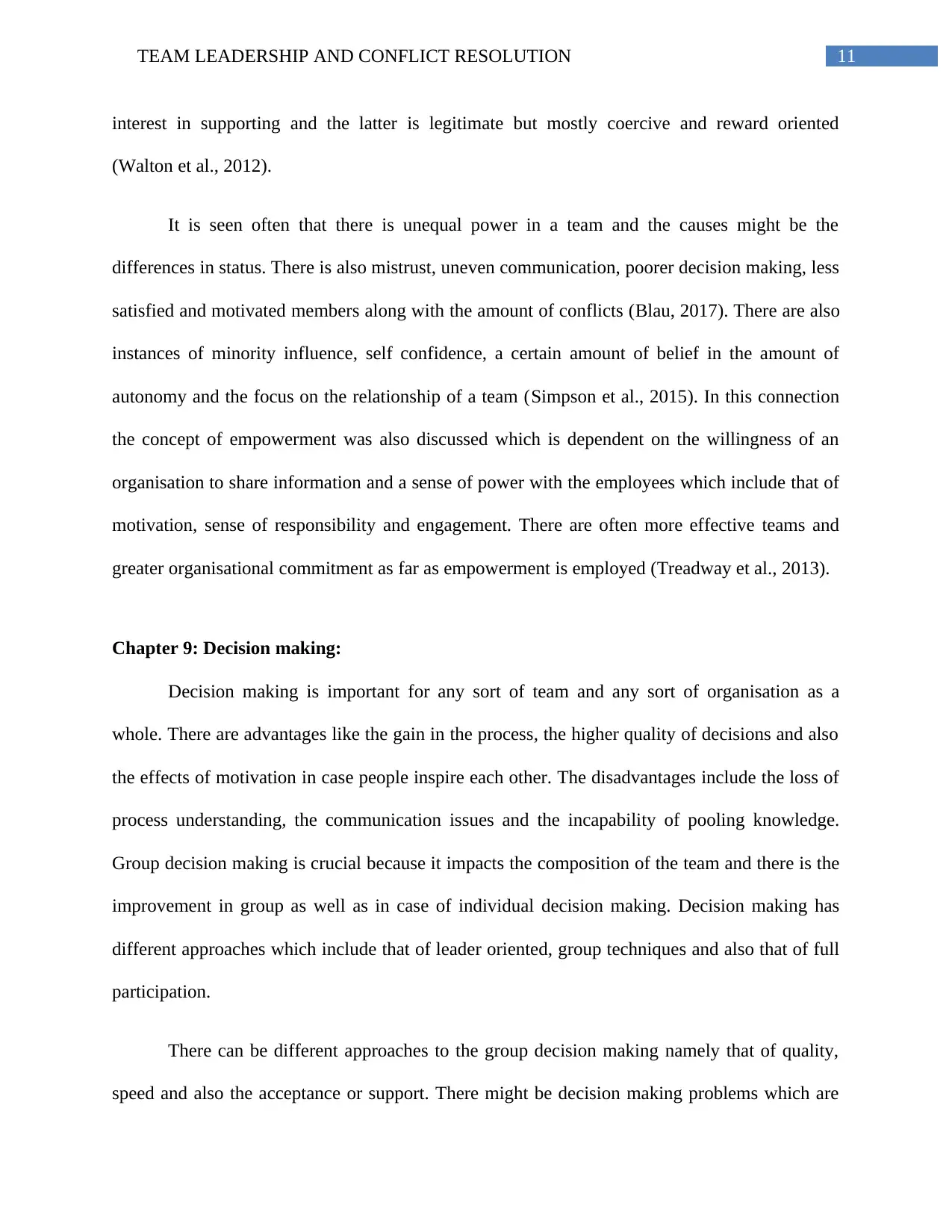
11TEAM LEADERSHIP AND CONFLICT RESOLUTION
interest in supporting and the latter is legitimate but mostly coercive and reward oriented
(Walton et al., 2012).
It is seen often that there is unequal power in a team and the causes might be the
differences in status. There is also mistrust, uneven communication, poorer decision making, less
satisfied and motivated members along with the amount of conflicts (Blau, 2017). There are also
instances of minority influence, self confidence, a certain amount of belief in the amount of
autonomy and the focus on the relationship of a team (Simpson et al., 2015). In this connection
the concept of empowerment was also discussed which is dependent on the willingness of an
organisation to share information and a sense of power with the employees which include that of
motivation, sense of responsibility and engagement. There are often more effective teams and
greater organisational commitment as far as empowerment is employed (Treadway et al., 2013).
Chapter 9: Decision making:
Decision making is important for any sort of team and any sort of organisation as a
whole. There are advantages like the gain in the process, the higher quality of decisions and also
the effects of motivation in case people inspire each other. The disadvantages include the loss of
process understanding, the communication issues and the incapability of pooling knowledge.
Group decision making is crucial because it impacts the composition of the team and there is the
improvement in group as well as in case of individual decision making. Decision making has
different approaches which include that of leader oriented, group techniques and also that of full
participation.
There can be different approaches to the group decision making namely that of quality,
speed and also the acceptance or support. There might be decision making problems which are
interest in supporting and the latter is legitimate but mostly coercive and reward oriented
(Walton et al., 2012).
It is seen often that there is unequal power in a team and the causes might be the
differences in status. There is also mistrust, uneven communication, poorer decision making, less
satisfied and motivated members along with the amount of conflicts (Blau, 2017). There are also
instances of minority influence, self confidence, a certain amount of belief in the amount of
autonomy and the focus on the relationship of a team (Simpson et al., 2015). In this connection
the concept of empowerment was also discussed which is dependent on the willingness of an
organisation to share information and a sense of power with the employees which include that of
motivation, sense of responsibility and engagement. There are often more effective teams and
greater organisational commitment as far as empowerment is employed (Treadway et al., 2013).
Chapter 9: Decision making:
Decision making is important for any sort of team and any sort of organisation as a
whole. There are advantages like the gain in the process, the higher quality of decisions and also
the effects of motivation in case people inspire each other. The disadvantages include the loss of
process understanding, the communication issues and the incapability of pooling knowledge.
Group decision making is crucial because it impacts the composition of the team and there is the
improvement in group as well as in case of individual decision making. Decision making has
different approaches which include that of leader oriented, group techniques and also that of full
participation.
There can be different approaches to the group decision making namely that of quality,
speed and also the acceptance or support. There might be decision making problems which are
⊘ This is a preview!⊘
Do you want full access?
Subscribe today to unlock all pages.

Trusted by 1+ million students worldwide
1 out of 16
Related Documents
Your All-in-One AI-Powered Toolkit for Academic Success.
+13062052269
info@desklib.com
Available 24*7 on WhatsApp / Email
![[object Object]](/_next/static/media/star-bottom.7253800d.svg)
Unlock your academic potential
Copyright © 2020–2025 A2Z Services. All Rights Reserved. Developed and managed by ZUCOL.





